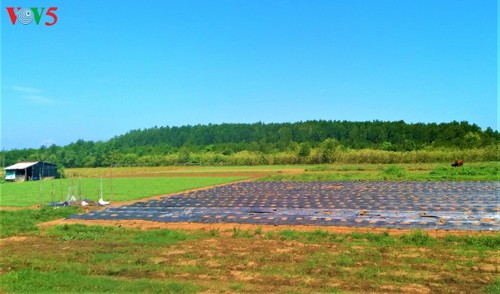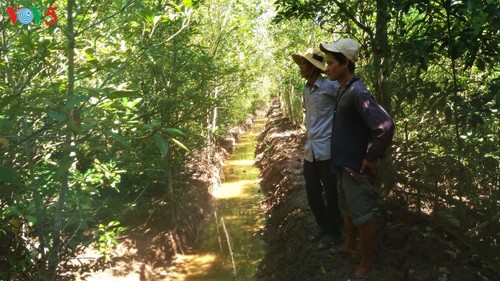 Protective forests in Au Tho B hamlet in Vinh Hai commune. Protective forests in Au Tho B hamlet in Vinh Hai commune. |
Au Tho B hamlet has surprisingly dense mangrove forests covering hundreds of hectares and stretching to the coast. The protective forest belt is part of a co-management model of mangrove forest protection sponsored by the German Society for Development Cooperation (GIZ). In return for protecting the forest, project members are allowed to go into the forest to harvest wood and aquatic resources under the canopy.
“Under the project, more trees have been planted. Each tree we plant can become two or three. Their roots retain the alluvium brought by the flood-tide, making the soil more fertile. The flood-tide also expands the forest by scattering the seeds of mangrove trees. You can get lost in the dense forest if you are not familiar with the terrain,” said Thach Soal, head of the Au Tho B co-management group.
With more than 70 km of coastline, Soc Trang is one of the localities in Vietnam most affected by sea water intrusion.
Nguyen Thanh Toan, Deputy Chairman of the Vinh Hai commune People’s Committee, says the local administration has promoted afforestation in response to coastal erosion.
“The outer forest has prevented erosion of the sea dyke system and sea water intrusion. The highest sea water level no longer reaches the dyke foot,” said Toan.
 The locals are involved in protecting protective forests. The locals are involved in protecting protective forests. |
Since 2011 SocTrang has planted 1,500 hectares of protective forest, bringing the province’s total protective forest coverage in coastal areas to more than 8,000 hectares.
“Planting coastal mangroves is the most effective and sustainable way to mitigate climate change. Under current conditions, if 70% of the mangrove forest survives for 4 years, it can be considered a great success. Soc Trang has been praised by the Ministry of Agriculture and Rural Development for its afforestation, leading the country in climate change response,” said Tran Trong Khiem, head of the provincial Forest Protection Sub-department.
Following the success of Vĩnh Hải commune, the mangrove forest co-management model has been replicated to other coastal districts in Soc Trang province. Soft embankments to reduce the strength of sea waves have been widely deployed to help the mangrove trees take root and form a protective forest.